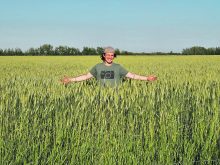INDIAN HEAD, Sask. — Caraway acreage isn’t huge compared to mainstream crops, but some farmers grow it.
In 2021, Saskatchewan farmers seeded about 2,100 acres.
“Caraway is a small but valuable spice crop,” said Bill May, Agriculture Canada research scientist at Indian Head during a recent field day.
He is examining companion crops for caraway. Normally, coriander would be a candidate but May said the disease complex of the two is too similar.
Early research has shown that peas are too competitive.
“Last year, there was very little caraway that even survived under the peas,” he said.
Read Also

Canadian Food Inspection Agency extends chronic wasting disease control program consultation deadline
Date extended for consultation period of changes to CWD program
“Even a fall-seeded cereal… winter wheat… it’s still too competitive for the caraway. Usually oats, if we bale it off as a greenfeed is not too bad.”
Of all the cereals, canaryseed did the best because of its open canopy in the spring. But one year (of) data showed that canaryseed is too competitive into the fall, delaying the caraway from flowering the following year, and growers have to then carry that caraway crop into a third year for the plants to flower and make seed.
Sunflowers have potential, but hemp actually did the best, May said.
Meanwhile, a nearby plot of niger seed drew attention from field day participants because of its golden yellow colour.
May said seed is available for anyone who wants to grow it, but no one should grow niger unless they plan to grow it, clean it and sell it themselves as birdseed.
“The insects will hit it for pollination really hard as soon as the bloom comes off the canola,” he said. “You can use leafcutter bees on niger. You can use honeybees as well.”
Cover crops get lots of attention in the greenhouse gas emissions and climate change debate.
In Saskatchewan, the best use of a cover crop is to produce nitrogen for the following crop and, if there is excess fall moisture, to use up water without having to till, May said. Using a cover crop properly could help farmers who have to go in and out of no-till to deal with the moisture.
Preliminary research at Indian Head is looking at various options.
May said a viny pea is far too competitive with the crop.
“It’s using up moisture and it’s depressing the yield of the crop and this is the last thing we want to see. In a dry year like this, we really don’t want to see that cover crop grow very much until we have moisture.”
In 2022, a 50-millimetre rain in July immensely boosted cover crops.
May said sunflowers were very tolerant of a cover crop, with hemp less so.
“Crops that tended to grow up in the canopy very high with the hemp tended to lower yields and the sunflowers could handle it a little bit better,” he said.
Buckwheat, hairy vetch, fenugreek and various combinations of those are being examined.
May said buckwheat is an option because the first frost will start to kill it and its vegetation won’t be a problem.
Vetch produces all its biomass at the end of the growing season after a crop. Lentils produce good biomass but farmers won’t want to use it as a cover crop if it’s a crop in their rotations.
“I’m looking at combinations of vetch and lentils and vetch and fenugreek… if we get excess moisture early we can use it with the fenugreek and lentils and then if we get that late season moisture we can produce biomass with the vetch,” May said.
“We’re looking at broadleaf crops because cereals are so damn competitive it’s hard to do anything with a cover crop in them. And we’re looking of course, at seeding the cover crop with the main crop because we don’t have time or moisture to do seeding after harvest.”
The trial calls for the cover crop to be harvested so that biomass measurements can be taken, although farmers would leave a cover crop on the field.
May is looking at other possibilities and said he is focusing on finding the right combinations first and then moving on to weed control. Main and cover crops that can use the same herbicides would be ideal.
















